Are there sharks in the Mediterranean? We don’t usually associate these fearsome fish with somewhere so many people love to go on holiday, but yes, there are. 47 of them in fact! And we’re about to run through some of the biggest, hungriest and best-known sharks in the Mediterranean for you below.
Fear not, though they can be found in everything from coral gardens to sandy shores to rock-filled reefs, they’re unlikely to come close enough to harm anyone going for a dip in the sea. That’s because the Mediterranean Sea is a pretty relaxed body of water, and the salty warmth means there are plenty of sea creatures that sharks can snack on. Bad news for these little guys, but good news for us!
What sharks do the Mediterranean Sea and Deep Sea World have in common?
Sand Tiger Shark
Rarely seen because of their small size and dwindling numbers, sand tiger sharks are actually cute and playful little things who won’t put humans in any sort of danger. However, they can get nervous around us and can be easily spooked. These sharks are known for losing around one tooth a day. They’re usually found in Beirut, though you won’t have to travel quite that far, since you can see them for yourself here at Deep Sea World!
Our 6 sand tiger sharks are called Arran, Lewis, Sleepy, Stumpy, Scout and Finn. Lewis is the biggest of them, but Scout isn’t too far behind, while Arran is the smallest of the boys! They get fed twice a week, with a diet that consists of tuna, and other fish like trevally and saury.
They are very relaxed boys and don’t need to constantly be swimming like other sharks! Sometimes you’ll even find Arran or Scout having a little nap on the bottom of the tunnel, so don’t be alarmed if you don’t see them moving, they’re just tired!
Catshark
Possibly the least “shark-looking” shark in the Med, catsharks are actually cute little creatures that are only 3 feet long and have soft fins. The small-spotted variety likes reefs and sandy seabeds, so if you’re lucky enough to see them while diving, you’re in for a real treat. The black-mouth and Atlantic varieties, however, live at depths so low that divers won’t ever come into contact with them.
Here at Deep Sea World we have two types of catsharks: Bamboo Catsharks and Lesser Spotted Catsharks. Known by many other names, including the Grey Catshark, Longtail Carpet Shark and Ridge-back, you can find these guys in our Krakatoa exhibit.
Lesser Spotted Catsharks, meanwhile, have a slender shark-shaped body with a blunt head, rounded snout and small dorsal fin. The nostrils are located on the underside of the snout and are connected to the mouth by a curved groove. You can try and spot this Catshark in our rockpool but we wish you luck, they’re hard to spot – hence the name!
Other sharks in the Mediterranean Sea
Blue Shark
It makes sense to start with one of the Med’s most common sharks. Usually spotted along the coast of France, Italy and Greece, the blue shark tends to call cool, deep water their home, so if they do make an appearance, it’s because they’re lost, young or stressed out.
And while they can reach lengths of ten feet, don’t fret, the blue shark poses very little threat to humans!
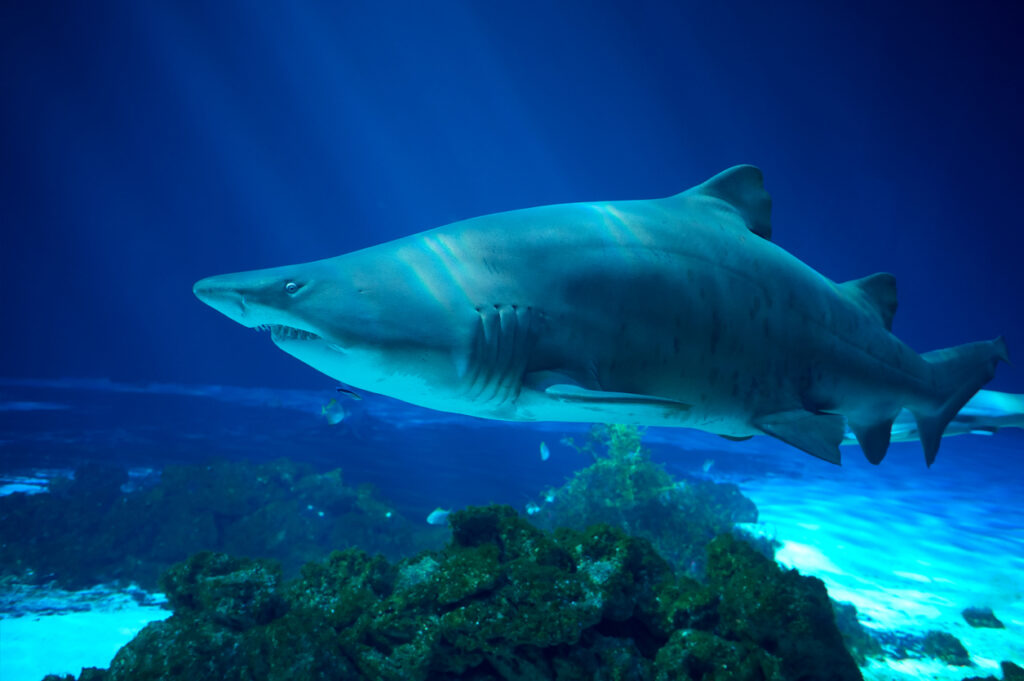
Grey Nurse Shark
With its 10-foot length, rows of sharp teeth and scary appearance, you could be fooled into thinking the grey nurse shark is a terrifying beast. But it’s actually a bit of a gentle soul – for a shark. They’re on the slow and docile side of things, and since they’re nocturnal, it’s rare for people to ever encounter them. Even so, the small size of its mouth means it’d be a challenge for them to chomp on us anyway!
Great White Shark
20 feet in length, 2 tonnes in weight and capable of reaching speeds of up to 16 miles per hour, the Great White Shark strikes fear into the hearts of humans and other sea creatures alike! However, it’s actually quite rare in the Mediterranean, and you’re more likely to see them lurking in the USA and Australia, and even then they’re not as common as you might think.
Black Tip Shark
So called because of the distinctive black on the tips of their fins, black tip sharks prefer shallow waters over deep depths. Wherever coral reefs, lagoons and bays are in the Med, you could well spot them swimming around. And although they’re fast swimmers who love to leap out of the water to catch their prey, there’s no need to worry. Black tip sharks are pretty timid around humans, and they’ll happily avoid them if they come into contact.
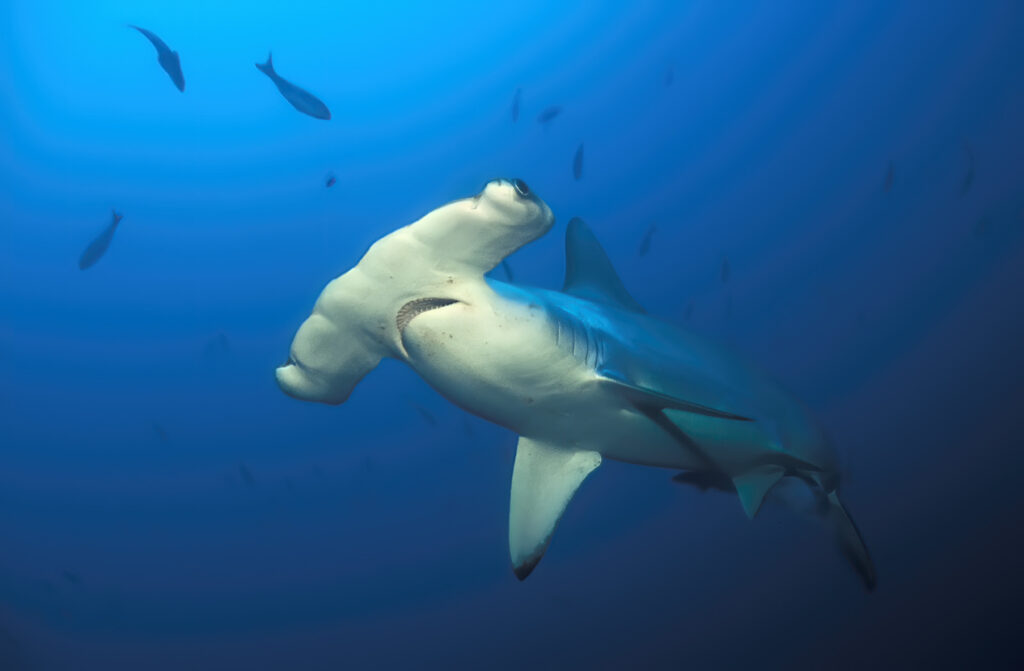
Hammerhead Shark
A species rather than a shark, three types of hammerhead sharks can be found in the Mediterranean Sea. The largest, the Great Hammerhead, reaches a length of 20 feet. Next, there’s the 16-foot Smooth Hammerhead. And lastly, the Scalloped Hammerhead, the smallest at 14 feet, but also the most common.
All three are aggressive too. And while they won’t actively go for humans, they’re prone to attack if they feel threatened. If you want to see them yourself, your best bet is at a safe distance or in a shark cage overseen by professionals.
Shortfin Mako Shark
Think you’ve just seen a dolphin flipping through the air? It might have actually been a shortfin mako shark instead! Known for their aerial acrobatics, these streamlined guys are muscular, speedy and highly agile. And while they’re more at home in tropical waters, they have a decent presence in the Mediterranean too. Unfortunately, these wonderful creatures are declining in number and they’re officially an endangered species now.
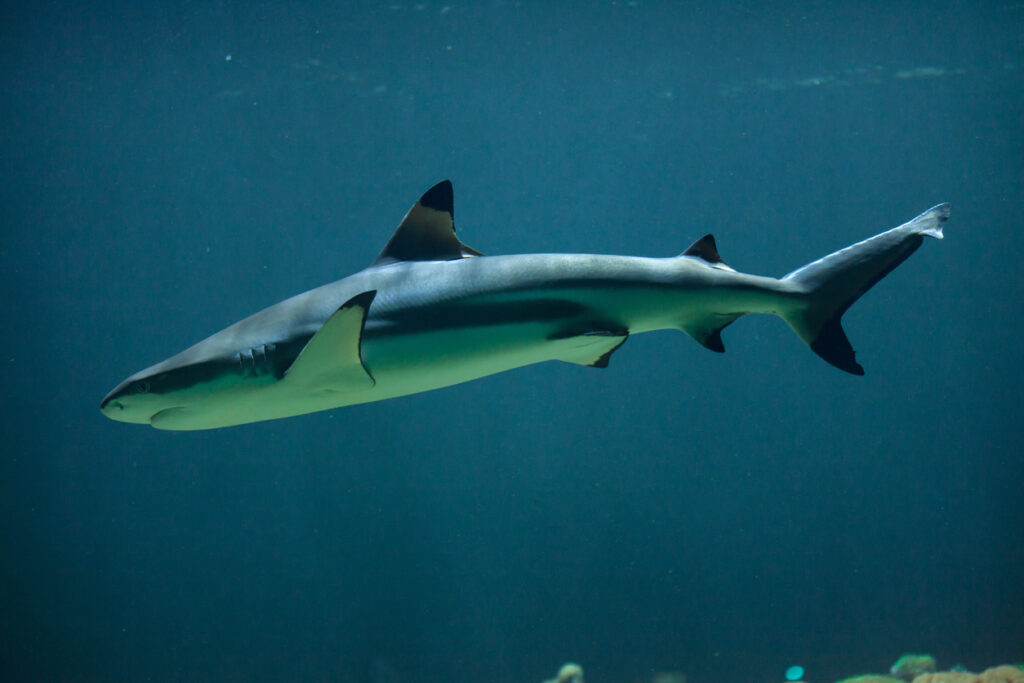
Spinner Shark
Often confused for black tip sharks for their appearance and similar fondness for warm, shallow waters, there’s no need to worry about being in danger around these guys. But why are they called spinner sharks? When it has its sights set on prey of its own, it moves in a fast, twisting motion before it pounces! Sadly, they’re over-fished for fins and liver oil so they’re listed as a vulnerable species – though there are fishing bans placed in certain areas.
Tiger and Bull Sharks
We’re grouping these together because they’re two of the most dangerous shark species to us in the whole world. They’re also very rarely seen too. In fact, it’s never actually been proven that the bull shark lives in the Mediterranean – though it’s been said to appear along the Italian coast.
The tiger shark, meanwhile, is thought to merely be passing through the Straits of Gibraltar whenever it does appear in the Med, so again, it’s difficult to know whether it’s actually a permanent resident or not.
Bluntnose Sixgill Shark
What a name right? The Bluntnose Sixgill shark has a distinctive title, but it’s pretty obvious why it’s called that. They have a blunt nose and six gills, of course! Also known as the cow shark, these sneaky creatures spend their day in the depths before coming closer to the surface when it’s dark in search of a midnight snack – and that can include other sharks, rays, large fish, squid, crabs and shrimp. They’ve even been known to nibble on bait left by fishermen!
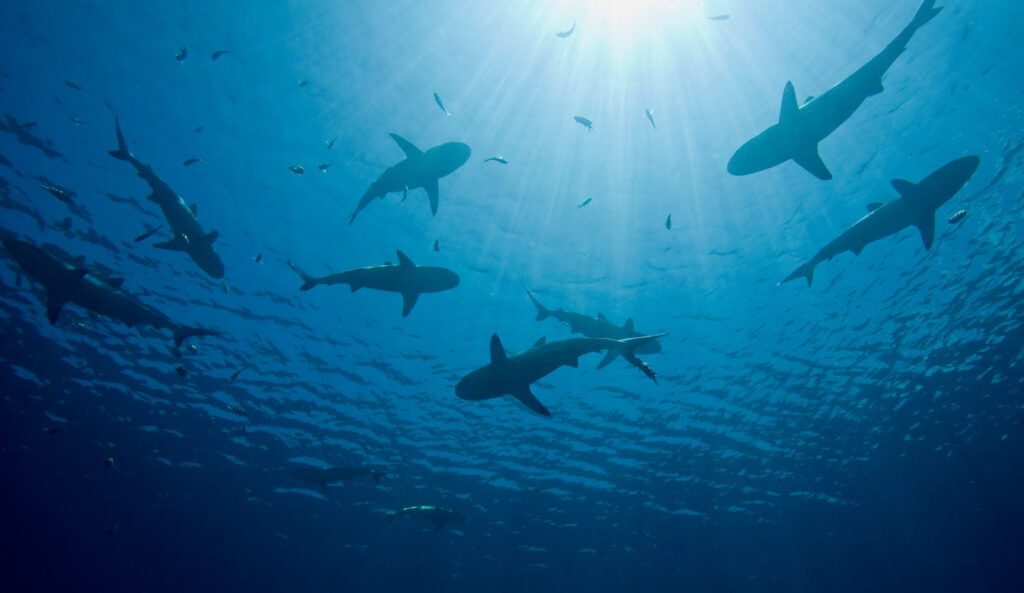
School Shark
Another common shark found in the Mediterranean, the school shark is known for its long, slender body and a snout that sticks out much more than other sharks – although they only grow to around 6.5 feet in length. As you can imagine from their name, they’re often found in large groups, usually separated by size and gender. Unfortunately, this makes them an easy target for fishers – and if a large group of females fall victim, then it means their population can rapidly dwindle as a result.
Spiny Dogfish
Of course, there’s a dogfish to go along with the catshark but these creatures are nothing like man’s best friend. In fact, they have spines in front of each dorsal fin, which they use to inject poisonous venom into their attackers! Some of them can even live up to 50 years old – although between 20 and 24 years tends to be the average. Still though, not a shark you want to come into contact with at any age.
Velvet-Bellied Lanternshark
Another incredibly named shark, this tiny variety grows no longer than 45cm. Despite their small stature, they have the amazing ability to produce light with their bodies. This skill, known as bioluminescence, lets them camouflage themselves from potential predators, and they even use it to communicate with each other! Making up for their diminutive size, such a feature allows them to survive much longer – essential when pretty much everyone else in the sea is bigger than you.
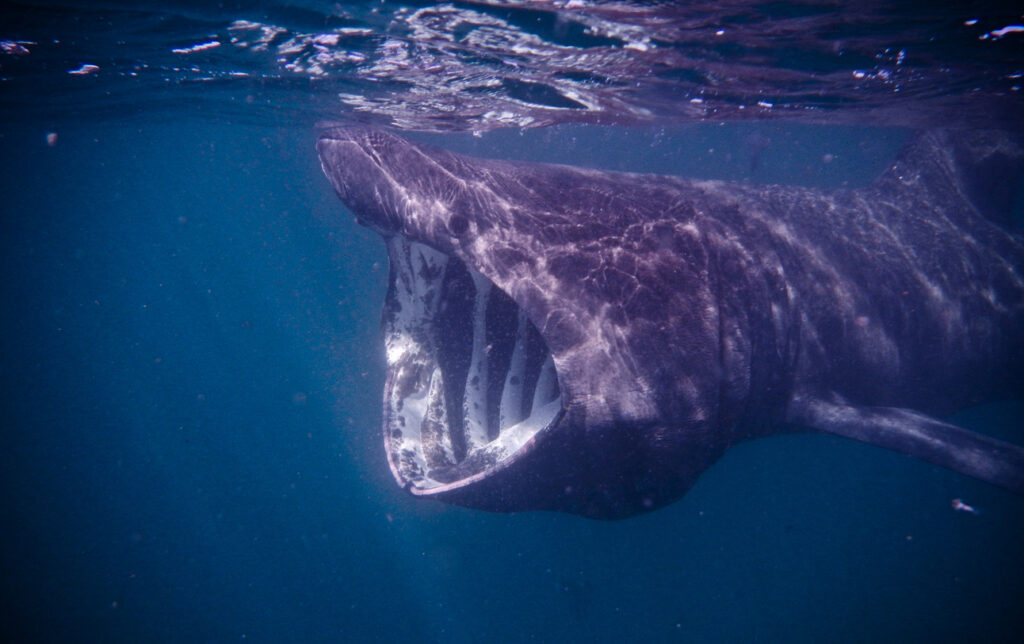
Basking Shark
One of the largest sharks found in the Mediterranean – about the length of a double-decker bus – the basking shark features wide-opening jaws with finger-like structures called gill rakers inside to stop food escaping from their mouths. And they can be found in the UK! If that sounds scary, don’t worry – they feed solely on tiny animals called zooplankton, so humans will never be on a basking shark’s menu any time soon.
For some more shark-y goodness, see how your knowledge stacks up by testing yourself with these ten questions all about the Ocean’s apex predators here.
Enjoyed our deep dive into these incredible creatures? You can find even more fascinating articles on our blog too. Looking to really go beneath the surface and see some of these amazing species yourself? Take a look at our homepage for more info on how to grab tickets to a Deep Sea World exhibit.
